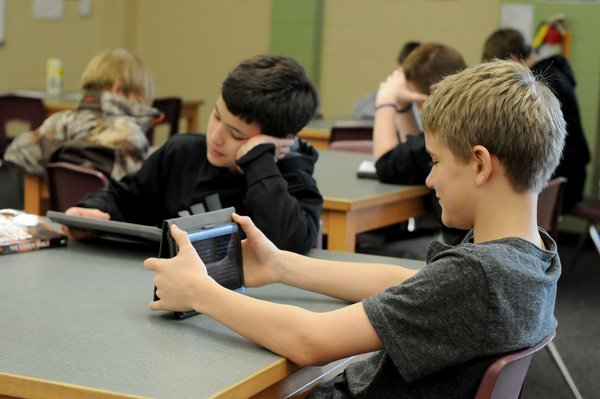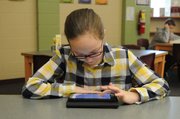FAYETTEVILLE — Some students are reading more books in school libraries and not because the books are more interesting or the titles more intriguing.
Reading, especially at middle schools, has taken a turn with iPhones, iPads, Nooks or Kindles loaded with electronic books, which may be the next step in the evolution of school libraries.
The Fayetteville Public Education Foundation last year provided a $19,500 grant to introduce e-books at all 14 school libraries in the district.
At A Glance
Bring Your Own Device Policy
Students in Fayetteville schools are allowed to bring their digital devices to school on occasion with the approval of building principals and teachers. To use their own devices, students must log in and use the filtered network provided in the classroom. The use of personal digital devices cannot interfere with an orderly classroom environment. Students should view online conduct as an extension of the physical classroom.
Source: Fayetteville School District
Students are allowed to use their personal electronic devices for assignments and research at school and, with their parents’ approval, can check out e-books. There are limits on the use of such devices and the implementation varies from school to school.
Fayetteville is one of the first in the state to embrace e-books districtwide, said Sarah Roberson, head of the district Library Council and high school librarian.
Marsha Jones, assistant superintendent in Springdale, said some schools are moving into e-books quicker than others, the same as in Fayetteville where implementation is at the building level.
At McNair Middle School more than half the students registered for e-book accounts, said Beth Lewis, a librarian.
That represents at least 358 electronic devices and some students have more than one.
“That’s a lot of Kindles, iPads and smartphones,” Lewis said.
The change from hard copy to electronic version may have created an upswing in student reading, Lewis added. The number of students who spend large amounts of time reading usually declines in junior high school as more activities become available, she said.
Students voiced mixed reactions about reading on electronic devices.
Ethan Griggs, 12 and in the sixth grade, estimated he spends up to six hours a day reading on his iPhone, especially historical novels and vampire romances.
“I read all the time and I don’t have to carry a book,” he said. Holding up his phone, he added, “This fits in my pocket. I can also listen to music as well as read.”
Kaitlyn Mashburn, 12 and in the sixth grade, reads on a 7-inch Acer tablet. Although she likes the portability of a tablet, she likes the feel of a real book, especially turning the pages by hand.
Another plus is she downloaded e-books not available in hard copy in the library to help with a class assignment on psychology.
Maggie Scarbrough, 12 and in the sixth grade, said she can keep the books she buys for her iPad. E-books also allows her to read books for older students that aren’t available in the McNair library. She may read three to four hours a day and goes back and forth between e-books and hard copies.
Nearly 1,000 e-books have been purchased, so far, and are divided by age category, Roberson said. The books are divided between the 14 campuses and separated by reading levels at the elementary level, middle school level for grades five through eight and high school for grades nine through 12, Lewis said.
E-books range in price from about $6 to $90, depending on the title and its staying power on library shelves, Roberson said. Harry Potter, for example, has staying power, Lewis said.
The district established a policy several years ago for selecting e-books. Teachers can ask for specific titles to be added to the libraries based on the books they plan to use in their instruction.
Students must register to check out e-books and a parent’s written consent is required. Then, a student can check out a book, according to the grade he is in, for 14 days. There is a renewal process if the student needs the book longer.
Students can check out a book at any time, day or night, and when school is not in session.
Librarians no longer have to nag students to return a book stashed in their backpacks for weeks or months.
“The book magically comes back in 14 days,” Lewis said.
“It cuts down on the loss,” Lewis said.
Another benefit is they don’t wear out, Roberson said.
Each school receives an annual budget allocation of about $10 per student to operate the school’s library. Schools do fundraising, such as book fairs, to boost the library budgets and seek grants, Lewis said.
The high school library has about 20,000 titles, including resource or reference materials, Roberson said. McNair has a collection of about 8,000 titles, including about 5,000 works of fiction, Lewis said.
For librarians, the challenge is managing two types of collections — print and electronic. E-books will continue to grow in number, the two librarians estimated. The goal now is to acquire more audio e-books.
Students aren’t interested in listening to audio books on a compact disc player. Students don’t have such players and view them as dinosaurs like eight-track tapes.
“If it’s not on a device, they aren’t interested,” Lewis said. “We have to go where they are.”
“To me, it’s new, it’s fun and kids are reading. To me, that’s success,” Lewis said.



